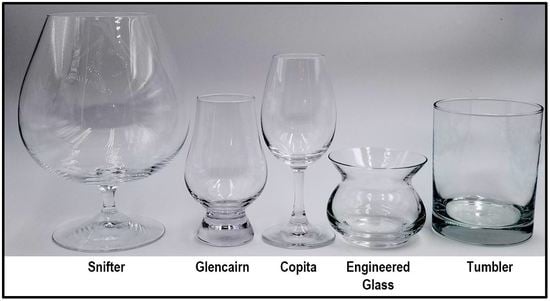Technical Report—Applying Physics and Sensory Sciences to Spirits Nosing Vessel Design to Improve Evaluation Diagnostics and Drinking Enjoyment
Abstract
1. General Introduction and Importance
- discover preferences and effects of ethanol on accurate diagnostics and evaluation
- examine validity of existing design assumptions through application of scientific principle
- provide general direction for identification of vessel design parameters.
- ethanol effects on the human olfactory system—Section 1.1;
- evaluation of existing common spirits vessels—Section 1.2;
- industry application of traditional vessel designs—Section 1.3;
- attempts to alleviate ethanol anesthesia with traditional vessels—Section 1.4;
- erroneous design assumptions that hinder vessel development—Section 1.5;
- gender preference and mindset regarding ethanol in aromas—Section 1.6;
- the importance of ortho-nasal aroma detection in spirits evaluation—Section 1.7;
- ethanol effects during multi-sample judging and evaluation—Section 1.8;
1.1. Ethanol Effects on the Human Olfactory System
- Causes pain to olfactory receptors especially in more sensitive noses.
- Irritates and enflames the olfactory epithelium, causing compensating mucous congestion further hindering smell detectability.
- Inhalation introduces ethanol through pulmonary system to the bloodstream, leading to cognitive impairment.
- Ethanol has anesthetic consequences for any of the 636 different olfactory receptors, as estimated by Godfrey et al. [4]. Further research is needed to identify and quantify the extent of ethanol–receptor binding and the possible existence of vibrational harmonics across the many different receptor types to determine how many may be affected.
- wide aroma display to facilitate separation and detection of more aromas
- avoidance of ethanol anesthesia by separating and diverting ethanol away from the nose.
1.1.1. Physical Properties of Ethanol
1.1.2. State of the Art of Olfactory Science and Applicable Terminology
- Ethanol lockout is hereby defined as an ethanol molecule binding to a single receptor, thus removing that sensor from the detection process until unbinding occurs.
- Ethanol anesthesia is hereby defined as the en masse ethanol lockout of an evaluator’s olfactory receptors to an extent that impairs aroma detectability.
1.2. Evaluation of Existing Common Spirits Vessels
1.3. Industry Application of Traditional Vessel Designs
- it is highly visible as the standard sherry tasting vessel, merchants’ quality verification tool, and has ready availability, public familiarity and acceptability;
- it was designed for higher ABV beverages, 22% vs. 12% ABV for wine, with smaller vessels more effectively controlling overindulgence than larger-sized vessels;
- it holds a 45 mL spirits serving, the common bar serving, while providing a small headspace, which is considered to be important for collecting and detecting aromas.
- small rim diameters restricting the nose from entering the vessel and concentrating ethanol;
- convergent, vertical or nearly vertical sidewalls, which concentrate ethanol;
- bowl diameters too small to accommodate swirling and the attendant tall headspaces;
- vessel rim heights too tall to detect some large-mass aromas.
Scotch Blenders Support Traditional Vessel Designs
- Bottled at 40%+ ABV, dilution of 1 serving with an equal amount of water yields 20% ABV. Consumers drink spirits straight at bottle strength, undiluted.
- 50% dilution forms a continuum mixture of ethanol and water, releasing some compound micelles while masking others. According to Conner et al. [9], Lersch [10] and Karlsson et al. [11], this degree of dilution frees long-chain fruity esters and masks short chains, smoky phenols, and oily, soapy, grassy, nutty, and cereal aromas, altering the aroma profile to one not experienced by consumers who drink straight spirits.
1.4. Attempts to Alleviate Ethanol Anesthesia with Traditional Vessels
- Breathe through mouth and nose simultaneously to avoid inhaling nose-numbing ethanol. Alleviates initial olfactory pain but delivers smaller air-diluted samples, affecting aroma detection. Ethanol concentration remains high, occupying more olfactory receptors with each consecutive sniff.
- Do not swirl. Swirling is the “engine” that propels evaporation. No swirling yields much less evaporation and fewer aromas to evaluate. Swirling is discussed inSection 2.1.
- Waft. Place vessel 15–20 cm from the nose, slightly below nostril level, wave aromas over the top of the glass toward nose to avoid pain and numbing. Wafting acclimates the olfactory receptors to prevent initial pungency of concentrated ethanol, ethanol lockout continues during sniffing.
- “Shake hands”. Position the glass about one foot away from the nose while sniffing, subsequently repositioning successively closer while sniffing, until rim is directly under nostrils. Gradual acclimation avoids initial nose burn but does not avoid lockout when sampling from small-rim diameter vessels. Ethanol vapor concentration remains at same high levels during sampling.
- Add water to open up aroma. Water raises liquid surface tension shutting down evaporation of all aromas, including those important to identification and evaluation. “Opening up” is the perception of relief occurring due to less pungent ethanol on the olfactory receptors.
1.5. Erroneous Design Assumptions Hinder Vessel Development
- Ethanol cannot be separated from other aromas. Scientific rationale for separation has existed since 1848 with Graham’s Law: Until now, Graham’s Law has not been applied to aroma separation.
- Convergent sides and small rim diameters are necessary to collect and concentrate aromas under the nose so none escape detection. Perhaps logical at first take, the most abundant molecule is ethanol with an attendant anesthetic effect. Convergent rims fail to focus aromas, and concentrate ethanol in a “cloud” which obscures and masks aromas at the rim where nosing occurs, forcing the evaluator to “pick and sort” through the cloud to find definable character aromas.
- Swirling releases nose-numbing ethanol, do not swirl. Swirling is necessary to create sufficient aromas for sampling, as many are obscured by the pungency of abundant ethanol. Proven with wine, swirling spirits is the “engine” that releases evaporation, transferring aromas to the nose.
- Tall, thin vessels focus aromas. Height restricts higher mass molecules from reaching vessel rims and detection. Lower vessel heights improve likelihood of higher mass aroma delivery. Gravity has some effect on aroma detection in tall, open container vessels.
1.6. Gender Preferences and Mindset Regarding Ethanol Aroma in Spirits
1.7. The Importance of Ortho-Nasal Aroma Detection in Spirits Evaluation
- assures the evaluator prior to tasting that no known aromas are poisonous or harmful, changing the evaluator’s mindset from trepidation “Is it safe to taste?” to relaxed and curious investigation “What do I smell?” “Can I recognize it?” “Do I like it?”.
- previews the aroma set to create anticipation of retro-nasal evaluation, “I smell orange on the nose, I will seek it in the finish”. Aroma memories have an effect on perception through disposition to particular aromas. Predispositions are well-known to panel administrators, who disallow conversation during primary evaluation, forcing reliance on individual diagnostic perception to capture first impressions without external suggestive influence.
Role of Flavor in Vessel Design
1.8. Ethanol Effects during Multi-Sample Judging and Evaluation
1.8.1. Observed Ethanol Anesthesia
1.8.2. Collective Ethanol Anesthesia may be a Potential Cause of Competition Event Ratings Disparities
2. Method
2.1. Cited Experimentation Methods: Discussion of all Experiment Methodology in Order of Experiment Appearance
- Snifter, 80 mm inside rim diameter, 130 mm inside height to rim plane;
- Glencairn 45 mm inside rim diameter, 90 mm inside height to rim plane;
- Copita, 40 mm inside rim diameter, 85 mm inside height to rim plane;
- Engineered Vessel, 79 mm inside rim diameter, necked, 35 mm inside height to neck plane;
- Tumbler, 80 mm inside rim diameter by 85 mm inside height to rim plane.
- Purpose: Identify and quantify favorable and unfavorable olfactory characteristics due to design and/or shape aspects of nosing and tasting spirits in each of three vessels commonly used in evaluations, particularly regarding the presence of detectable ethanol aroma.
- Objective: To identify existing design factors of common evaluation vessels which contribute or detract from objective spirits evaluation due to olfactory ethanol.
- Materials: Vessels for each evaluation shown in Figure 2: Control spirits of bourbon, scotch, aged rum, reposado tequila, VSOP cognac, gin, vodka, 45 mL per sample.
- Conditions: Ambient temperature 24–25 °C, isolated room, free from abnormal noise and distraction, well ventilated and free from perceptible air currents.
- Methodology: Subjective evaluation by experienced panelists to assess and estimate ethanol contribution to aroma profiles of various common vessels. These tests are qualitative opinions conducted for experienced internal design direction only.
- Procedure: Maximum of three control spirit evaluations were held in a single day, and multiple evaluations were spaced at least 30 min apart to ensure complete olfactory recovery from aroma adaptation prior to subsequent trials. Repeat trials with the same control spirit were performed on different days. Two trials were performed for each control spirit. No taste sampling of spirits was allowed during olfactory evaluations, or between multiple evaluations. Brands, bottles and labels of control spirits were hidden from panelists to avoid familiarity influencing outcome. Each panelist evaluation was individually secluded and monitored to ensure adherence to procedures and enforce the ten-minute time limit per trial. Immediately after individual evaluation completion, notes were collected and panelists were assembled to discuss vessel shape characteristics affecting results. One evaluation consisted of one control spirit, four evaluation vessels sampled in order in anticipation of the effect of shape on induced ethanol anesthesia: tumbler, Glencairn, copita, and snifter. All vessels were covered to prevent ambient aroma mixing and all remained covered except sample being evaluated. Participants were instructed not to swirl, then uncover, smell, recover, and evaluate; then to repeat with swirling for each vessel, noting:
- estimated percentage of ethanol vs. other aromas before and after swirling.
- rank vessels in order of lowest to highest ethanol detection.
- Results and Conclusions (Table 2): Collective comments are summarized in the table. Estimated ethanol aroma percentage is the numerical average of all trials with all control spirits except vodka, for which data was discarded due to high variance in character aroma detection. Estimated ethanol percentage data for all other control spirits were averaged together (individual highest to lowest numerical variance 8%). Panel agreement was unanimous regarding three major design issues: (1) small rim area vessels tend to concentrate ethanol, creating difficulty with specific aroma detection; (2) Glencairn and copita exhibit identical issues with aroma detection, i.e., high ethanol concentration, swirling difficulty; (3) snifter vessel promotes ethanol over character aromas by creating an ethanol dominant aroma mixture impeding specific aroma detection. Vessel rank from lowest to highest ethanol was unanimous: tumbler best, snifter second, and Glencairn and copita last, but equal. Swirling is best in snifter, then tumbler, with Glencairn and copita last, but equal. Trial repeats verified results for each vessel with each control spirit.
- Purpose: Determine preference for ethanol in the aromas of spirits from two different vessels, a prototype of the subject engineered vessel which dissipates ethanol aroma and a standard tulip vessel which concentrates ethanol.
- Objective: To test market the radical design and appearance of the engineered vessel against the widely accepted industry standard vessel and to discover ethanol aroma preferences of men and women who drink spirits “neat”, without water, ice or mixer.
- Materials: Standardized vessels used for each evaluation: (1) standard copita, and (2) engineered vessel. Control spirits were always bottled at 40% ABV; bourbons, scotch, rums, blanco and reposado tequilas and gins, 45 mL per sample, approximately a standard single serving which is design capacity or “best fill” for all vessels. Early experimentation from Table 2, Consumer Test I exhibited no difference in ethanol perception between copita and Glencairn, and Glencairn was used in many subsequent trials due to familiarity with event attendees. For reference, (c) denotes copita and (g) Glencairn in Table 2. Additionally, there were no differences in perceptive ethanol for 40% ABV spirits of different origin, grain, fruit, sugarcane, or agave. Control spirits were donated by spirits manufacturers attending the events.
- Conditions: Ambient temperature 24–26 °C, large auditoriums, exhibit halls, and hotel ballroom suites, crowded and noisy.
- Background: Over a span of nearly five years, Arsilica, Inc. researchers attended spirits industry tradeshows to present a version of the well-known “Pepsi Challenge” at random to those who agreed to participate. Multiple challenges with as many as three stations were employed at several events.
- Methodology: AB consumer discrimination testing. Real-world setting with naïve, random, non-screened spirits event attendees with an interest in tasting spirits, no incentives to participate were offered.
- Procedure: No taste sampling of spirits allowed, evaluation was restricted to olfactory. All samples remained covered between samplings. Control spirits bottles and brands were visible to participants. Each participant was asked to first swirl and sniff the engineered glass sample keeping nose at the rim plane holding glass level, then to sniff the tulip glass. This order ensured that strong, higher velocity sniffs of concentrated ethanol did not numb noses prior to detecting aromas from the engineered glass. Challenge station moderators asked which was preferred and reasons for choosing, and responses were recorded by gender. Further questioning was directed to males who preferred the tulip aromas with strong ethanol to discover reasons for their preference.
- Results (Table 3): The total number of recorded trials is 2914. Of the males who participated, approximately 13% preferred ethanol on the nose, standard deviation 2.23%, and less than 2% of females preferred ethanol on the nose, standard deviation 1.37%, both with 2σ and 95% confidence level confirming previous assertions that women are more sensitive to pungent concentrated ethanol aroma. Further questions were asked of those males who preferred ethanol in the aroma to determine mindset. Results of these questions uncovered a particular attitude among male spirits drinkers, which is noteworthy and should inspire additional research to determine reasons for preference of ethanol. Polled participants attended events for the purpose of sampling straight spirits offerings from distillers or distributors and were familiar with drinking spirits straight, neat, no ice, water, or mixer.
- How old are you? Two-thirds of polled males preferring ethanol aroma are over age 45, suggesting a cultural difference toward ethanol for younger males. Unfortunately, the importance of this question was lost on the research team, and ages were not recorded for the entire polled population.
- When do you generally drink straight spirits? Most common responses were: with friends and acquaintances, “guys night out”, happy hour after work, bachelor and birthday parties, watching sports, and other male gender-specific activities. Many commented that females seldom attended spirits drinking group activities.
- The mindset of males who preferred ethanol is summarized in comments after sniffing the engineered vessel. Of the 13% of males who preferred ethanol aroma, many insisted that the engineered vessel must contain a lower-quality spirit and 63% of those commented that higher presence of ethanol indicated higher quality. Of males preferring ethanol, just over a third considered themselves above average in knowledge of their favorite spirits. Additionally, the 13% of males preferring ethanol disliked the engineered vessel for the most common reasons in order of frequency (1) “I use the Glencairn”; (2) “There is no aroma”; and (3) “...it looks like a flower vase or spittoon or goldfish bowl”. Preference and intent to follow the vessel identified with and supported by industry was well apparent in the responses of the majority of the 13% of males who preferred ethanol aromas.
- Conclusions: The vast majority of participants preferred no ethanol on the nose, and most of those that preferred ethanol had opinions that ethanol belongs in the aroma of spirits. The vast majority of females preferred no ethanol, supporting the referenced study that females have more sensitive noses than males.
- Purpose: Compare spirits aroma detectability of retro-nasal spirits evaluation only versus traditional evaluation which includes both ortho-nasal and retro-nasal sampling.
- Objective: To determine if retro-nasal CSTEM evaluation method provides as much aroma information as long-held method which utilizes ortho-nasal first, then retro-nasal evaluation sometimes called “finish”.
- Materials: Copita used for all evaluations, with control spirits of bourbon whiskey, scotch whisky, and gin, all 40% ABV. Aged and botanical spirits demonstrate higher aroma availability for evaluation, and unaged spirits and vodka were not considered.
- Background: Proposed C-STEM method introduced by Adam Carmer [14] to eliminate vessel shape effects on spirits aroma presentation, and alleviate ethanol olfactory fatigue. The C-STEM method is performed in three steps: (1) do not smell or swirl spirit prior to tasting, as different vessels deliver different aroma presentations; (2) place liquid sample directly in oral cavity; (3) slosh around, over and under tongue, and hold long enough to mix saliva secretion with spirit until palate pain subsides; (4) swallow, note retro-nasal aromas.
- Conditions: Ambient temperature 24–25 °C, isolated room, free from abnormal noise and distraction, well lit, well ventilated and free from perceptible air currents.
- Methodology: Subjective evaluation by experienced panelists to determine aroma detectability excluding ortho-nasal evaluation to determine ortho-nasal aroma contribution.
- Procedure: Multiple evaluations were spaced at least 30 min apart to ensure complete olfactory recovery from possible aroma adaptation. No taste sampling of spirits was allowed during olfactory evaluations or between multiple evaluations held on the same day. Each panelist was monitored by a member of the research team to ensure compliance with procedure. Brands and labels of control spirits were not disclosed to panelists. Panel of eight participants evaluated three control spirits. C-STEM evaluations performed in accordance with the C-STEM method, recording each different aroma detected during each control spirit trial. Trials were repeated with the traditional method, smell and evaluate ortho-nasally, taste and evaluate retro-nasally.
- Results (Table 4): Data from all eight panelists, counting only unique aromas:
- Bourbon:
- First trial set. C-STEM method—the total number of different aromas detected by all panelists from bourbon sample was 7: ethanol, spice, charred oak, honey, orange, vanilla, caramel. Traditional method yielded 3 additional aromas of floral, butter, and nuts.
- Second trial set. C-STEM method—the total number of different aromas detected by all panelists from same bourbon sample was 7: ethanol, honey, vanilla, orange, nuts, butterscotch, and spice. Traditional method yielded 4 additional aromas of caramel, butter, fruit, floral.
- Scotch:
- First trial set. C-STEM method—the total number of different aromas detected by all panelists from scotch sample was 5: ethanol, honey, caramel, spice, and butter. Traditional method yielded 2 additional aromas of floral, lemon or citrus.
- Second trial set using same scotch sample was a repeat of first trial set.
- Gin:
- First trial set. C-STEM method—the total number of different aromas detected by all panelists from gin sample was 3: ethanol, juniper, and licorice. Traditional method yielded 2 additional aromas of floral and lemon or citrus.
- Second trial set. C-STEM method—the total number of different aromas detected by all panelists from same gin sample was 3: ethanol juniper, and licorice or cardamom. Traditional method yielded 2 additional aromas of spice and floral.
- Conclusion: C-STEM is not an acceptable evaluation method to alleviate ethanol anesthesia during evaluation diagnostics, due to unsatisfactory aroma detection most likely caused by elimination of ortho-nasal component of evaluation.
- Purpose: Determine the point at which ethanol anesthesia begins to affect spirits competition judges’ ability to evaluate and rate spirits through simulation of a competition event with a tulip style vessel.
- Objective: Simulate spirits judging competitions and evaluate unique aroma detection to determine precise occurrence of ethanol anesthesia, and possible causal factors.
- Materials: Copita vessels as shown in Figure 2. Various spirits in 20 mL samples supplied by Arsilica, Inc., varied by event. Dump buckets provided for each panel were replaced clean for every flight to avoid aroma pollution. Score sheets describe each sample with respect to standard competition category and construct, including pertinent details such as ABV, blended or not, source of ethanol. Brand names, geographic distillery locations were excluded, and samples were prepared out of sight of judges.
- Background: By observing competitions which use a copita-style nosing glass for judging and evaluation and discussing occurrences of olfactory fatigue with competition administrators and many experienced judges, Arsilica, Inc. researchers discovered that during most competitions, judges appear to fail at detecting significant aromas and their written tasting notes begin to lack critical detail by the third flight of samples. Many judges express difficulty in describing aromas, detect unrecognizable aromas, or complain that aromas are not evaporating from the spirit because it is “tight”. Many competitions are under pressure to complete judging in a single day and push to complete as many flights as possible in a short amount of time, also increasing the number of samples per flight. During competitions, the next flight to be evaluated is poured ahead of completion of the flight being evaluated, and as tables from the completed flight are bussed clean, the new flight is being placed in front of the panelists to save time for completing the event. Recovery time from ethanol aroma adaptation is not factored into the timing of flights, sample sizes are approximately 20 mL, judges are instructed to dump and spit residual spirits, none appear to be intoxicated or inebriated, speech and eye clarity, where noted, is normal.
- Conditions: Ambient temperature 24–25 °C, isolated room, free from abnormal noise and distraction, well lighted, well ventilated and free from perceptible air currents. White table cloth background for best lighting, all judges seated at a single table. All samples covered to prevent ambient aromas from affecting aroma counts.
- Methodology: Quantitative spirits evaluation simulating real-world competition event procedures and timing using experienced evaluators qualified to judge competition events. Number of judges, samples, and flight arrangements are well within the scope of most existing competitions.
- Procedures: Maximum number of samples set at 8 to simulate sample sizes noted through prior event participation. Flights similar to competitions with clear, unaged spirits first. Order of flights in all event simulations were (1) Vodka; (2) Gin; (3) Barrel-Aged Whiskeys; (4) Barrel-Aged Whiskeys; (5) Rums. Four flights prior to a long break could confidently provide the necessary number of evaluations to induce ethanol anesthesia as its approximate point of occurrence as determined from discovery and event experience, and a single flight post break is sufficient to ensure olfactory recovery from aroma adaptation. Although many competitions may have more than one flight of vodkas and gins per panel, whiskeys were purposely set for flights three and four to provide spirits with more inherently available aromas to detect during a time frame in which suspected ethanol anesthesia occurs in actual competitions. Judges differed for each event, but were the same for all flights of a specific event. Judges were instructed to maintain silence and note each and all aromas on their score sheets from both ortho-nasal and retro-nasal traditional evaluation, which were then removed from the tables when all judges had completed notation to prevent post-evaluation changes or additions. As in actual competition, judges were allowed to resample, discuss and assign mock award levels based on the commonly used system of double gold, gold, silver, bronze, and no award, prior to bussing and resetting for next flight. Performing this procedure accurately simulated actual competition timing. Judges were instructed to spit after sampling and dump residual spirits. Monitors ensured adherence to spit and dump procedures to prevent possibility of intoxication during evaluations.
- Results (Table 5): Please note that data is expressed as number of aromas/number of samples. The first flight of vodkas exhibited a high number of aromas in every event simulation, similar to actual competitions, as judges are fresh and at their best. The gin flight also produced many total aromas in all event simulations. Aged whiskeys commonly display about eight detectable aromas, yet judges determined only 3–5 unique aromas in flight three, with similar performance in flight four for each event. Aroma count correlates to discussions with experienced judges who readily admit difficulty in aroma detection by the third flight regardless of spirit. For all events, elapsed time to complete 4 flights averaged 2½ h, maximum variance 27 min.
- Conclusions: Close examination of results and procedures did not uncover specific causal factors for the apparent occurrence of ethanol anesthesia in flight three and continuing into flight four according to aroma count. Determination of the point of ethanol anesthesia onset or possible causal factors were inconclusive. The onset could have begun as early as sometime during the group discussion, post silent evaluation, of previously evaluated flight 2. No obvious flaws in procedure were noted. As suspected from discovery, simulated competitions appear to validate the occurrence of ethanol anesthesia, yet there was no conclusive determination as to point of occurrence or causal factors. Flight five results validate that a long break restored olfactory sensitivity and recovery from aroma adaptation was complete during each event. The occurrence of ethanol anesthesia could be alleviated by; (1) using a vessel which dissipates ethanol away from the nose; and (2) specified longer break periods between flights to ensure that recovery from aroma adaptation occurs prior to each flight, possibly inserting a break after every two flights.
- Post-Simulation Field Testing of Engineered Vessel: The engineered vessel has been used in over 100 competition events over a period of 6 years, with no reported instances of ethanol anesthesia. Over 40% of those competitions were monitored onsite by Arsilica, Inc. researchers and tasting notes and observations resulted in no degradation in expected aroma counts detected per panel prior to mid-day break, which included 4–5 flights prior, and no complaints of aroma detectability.
- Purpose: Determine spirit aroma detectability as a function of nostril distance from liquid surface.
- Objective: Establish the maximum height from the liquid surface to the nostril at which one can detect the highest unique aroma count.
- Background: General assumptions of ideal gas behavior and random molecular motion in a closed system is frequently and mistakenly applied to an open system. In an open system, molecules are continually leaving the container to be replaced by those evaporating at the liquid surface. Gravitational effect on molecular mass and complex molecular shape are commonly acknowledged as the reasons that more aromas are detectable closer to the liquid surface.
- Materials: The tumbler pictured in Figure 2 was used with various fill levels to achieve different evaluation heights. The tumbler was chosen as the test vessel as being large enough to minimize vessel manipulation of ethanol and aroma profiles. Control spirits of bourbon, scotch, tequila, gin, cognac, aged unspiced rum, and vodka.
- Conditions: Ambient temperature 24–25 °C, isolated room, free from abnormal noise and distraction, well lit, well ventilated, yet free from perceptible air currents.
- Methodology: Monitored individual spirits evaluation in laboratory conditions by experienced evaluators to determine a critical design dimension for aroma detectability.
- Methods and Procedures: Eight panelists for each trial were each supplied with a single tumbler control vessel, marked with a vertical masking tape level indicator to denote liquid fill levels for surface to rim plane heights of 7, 5, 3, 2.5, 2, and 1 cm. Panelists were instructed and monitored to sniff and note aromas with vessel flat on the table, positioning nostril opening at the rim plane. Panelists were allowed to relocate nostrils to different horizontal positions within the rim plane, maintaining same vertical proximity to the spirit level. When evaluation at a single level was complete, the vessel was filled to the next level and test sniffing repeated, until the level reached 1 cm below the rim plane. Level evaluations were spaced every 10 min to ensure recovery from possible aroma adaptation. Liquid was stirred at each level to generate evaporation. Data was recorded on the same page in successive columns left to right in decreasing surface to rim plane heights. Aromas recorded from previous fills remained on the data sheet for reference. Each control spirit was evaluated twice in separate trials and repeatability was verified.
- Results (Table 6): The table denotes aromas detected from the single bourbon control spirit trial for all panelists, and specifies additional unique aromas noted at each successive fill for each panelist. Bourbon, scotch, anejo tequila, aged unspiced rum, and cognac all required a maximum of 2.5 cm to detect all available aromas. For vodka, all aromas, that is no additional aromas were detectable below 5 cm.
- Conclusion: Subjective evaluation reveals that nostril height from surface of the liquid is important to detecting aged spirit aromas, and 2.5 cm is sufficient rim height for diagnostic evaluation. Larger mass aromas become more detectable as nostrils approach liquid surface. See Table 7 for molecular mass of many aromas. Molecular mass affects aroma detectability. Detectability by molecular shape is beyond the scope of this evaluation but may be important. Other chemical properties such as vapor pressure, hydrophobicity and solubility are important as well but will not be addressed here.
2.2. A Scientific Approach to Vessel Design and Dimensions
2.3. Vessel Bowl Diameter Ergonomics and Improving Swirling
- after swirling, downward flow of fluid on vessel sidewall results in “legs” or tears” caused by the surface tension gradient between cohesive water and ethanol, disrupting surface tension and improving evaporation as they tend to separate, known as the Gibbs-Marangoni effect.
- gravity creates vertical shear on vertical vessel sides, disrupting surface tension and improving evaporation as liquid returns to the liquid pool.
- thin wetted liquid layers on the vessel sidewalls create a quick, short path for rebounding molecules to break surface tension, improving evaporation; whereas the large volume of a liquid pool tends to absorb the motion of molecules rather rebounding to test surface tension.
2.4. Vessel Height
2.5. Convergent Rim vs. Divergent Rim
2.6. Synergy of Combining Both Configurations Separates Ethanol
- lower, below the restriction, is the evaporation chamber, in which evaporated aromas are encouraged to vaporize by swirling to wet vessel side walls.
- upper, above the restriction, is the expansion chamber, controls dispersion and diffusion of molecules compressed in the neck and directs expanded higher velocity ethanol molecules over the rim and away from the nose. The straight, linear lip from neck to rim defines a volume bounded by the orifice and rim planes, and provides an unobstructed, controlled escape path and expansion volume for diffused molecules (Figure 5).
2.7. Application of Gas Kinetic Theory and Graham’s Law
- Convergent sides concentrate molecules increasing collisions and small molecule velocities. From the kinetic energy equation:Particle velocity is inversely proportional to the square root of its mass. Convergent bowl increases molecular flux and impingement rate at the orifice, imparting higher velocities to lower mass molecules, especially lowest mass and highly abundant ethanol.
- Divergent sides allow dissipation. Applying Graham’s law to compare diffusion rates of two gas components, the equation becomes:
2.8. Ethanol Path after Separation
2.9. Lip Angle
2.10. Nose Position
2.11. Sizing the Orifice
- smooth, gradual unobstructed flow from expansion chamber into orifice
- flow compression to increase molecular collisions raising lower mass particle velocities
- quick ethanol expansion, diffusion and controlled escape
- wide character aroma display inside the rim away from ethanol dispersion.
2.12. Shape Curve
- maximizing evaporation area of liquid surface at lower fluid levels during drinking by maintaining large bowl diameters at lower fluid levels in fill portion of evaporation chamber;
- permitting aromas to flow smoothly and uninterrupted into the orifice;
- sidewall curvature to facilitate swirling without spilling;
- providing uninterrupted ethanol flow along divergent surface to rim in expansion chamber.
2.13. Vessel Volume
2.14. Dimensions and Shape of the Engineered Vessel
2.15. Manufacturing Dimensions of Subject Engineered Vessel
2.16. Recommended Vessel Usage and Nosing Procedure
- Fill to maximum bowl diameter, 45 mL. Note: 20 mL sufficient for evaluation only;
- Cover vessel when not sampling to prevent aromas from tainting atmosphere and allow equilibrium to occur, about 5–10 s, further intensifying sample aromas;
- Swirl vigorously prior to each nosing, position vessel under nose, uncover;
- Holding vessel level, place nostrils over rim plane intersect with central vertical axis with closed lips placed on vessel rim to aid in central nostril placement. Caution, placing nose into or below orifice plane exposes olfactory to highly concentrated ethanol;
- Keep mouth closed, inhale lightly and slowly through nostrils only to sample;
- Move nose radially along rim plane slowly toward rim edge to detect lighter aromas. Highly diluted ethanol and volatile aromas appear at rim edge;
- Evaluate ortho-nasal aromas and take notes;
- Sip, taking only enough spirit into oral cavity to completely coat oral cavity including palate, roof, sides, under tongue, bringing all available sensors into play;
- Hold in oral cavity, slosh until saliva assuages palate burn, open mouth;
- Smack tongue against upper palate while lightly mouth breathing to break increased surface tension from saliva. Close mouth to savor, and evaluate retro-nasal finish;
- Record notes, replace cover, return later and re-evaluate to verify or expand description;
- Do not add water to spirits as all aromas will shut down from increased surface tension. The vessel adequately redirects ethanol to prevent nose pain or ethanol anesthesia. If palate pain is an issue, pour spirit into a separate vessel to add water to oral preference, and continue to sample original for olfactory diagnostics only.
3. Results of Testing:
Projected Impact and Benefits of Results
- largely diminishing occurrences of ethanol anesthesia for evaluators, blenders, distillers, and consumers through use of an improved diagnostic vessel;
- providing wider, more efficient display of character aromas, desirable and undesirable to improve evaluation accuracy, diagnostics and rating, unencumbered by ethanol;
- improving competition aroma detection by widening aroma display area;
- eventually, awareness may raise the industry quality bar and consumer quality expectations by exposing aromas of distilling faults, as well as desirable aromas masked by ethanol;
- creating a viable candidate for diagnostic vessel standardization to improve industry quality, allowing distillers, evaluators, and consumers to establish a uniform evaluation baseline across industry segments;
- improving spirits marketing to include more sensitive noses and more female consumers to enjoy straight spirits without olfactory ethanol;
- providing a useful tool to distillers to improve accuracy of head and tail cuts;
- providing a useful tool for other aroma and scent applications such as perfumes, coffee, tea, olive oil, distilled flavor infusions and food flavor enhancers;
- improving consumers’ ability to assess spirits for purchase, collection, and consumption;
- enhancing drinking enjoyment and displaying subtle nuances of distilled spirits, especially for noses sensitive to the painful effects of concentrated ethanol.
4. Discussion
5. Conclusions
- an awareness of ethanol anesthesia as a potential problem to competent evaluation, and the need for further research to quantify onset, exposure times and causal factors;
- the importance of orifice constriction and flared rim design architecture for consideration as a design method to dispersing ethanol and displaying aromas;
- the importance of considering vessel design factors which place the nose closer to the spirit, utilize rim sizes which allow the nose to detect aromas displayed by a flared rim, and permit higher-velocity swirling, which releases more aromas for detection;
- the initial basis for a mathematical model to predict aroma detectability from a flared rim vessel for any spirit;
- a basis for improved research on product design effects on aromas detection and vessel design objective prioritization of function over style;
- creation of useful, descriptive terminology, directly related to function to specifically address effects of olfactory ethanol consistent with modern olfactory theory, those terms being ethanol lockout and ethanol anesthesia;
- the need for directing specific attention to the unaddressed effect of ethanol on more sensitive female olfactory senses, to inspire additional research to include sensitive noses in evaluation and vessel design.
6. Patent
- USPTO Design patent D663165 granted, USPTO and WIPO Utility patents pending;
- People’s Republic of China Utility patent ZL 2012900007787 granted.
Supplementary Materials
Funding
Acknowledgments
Conflicts of Interest
References
- Wood Library Museum of Anesthesia. History of Anesthesia Timeline; Wood Library Museum of Anesthesia: Schaumburg, IL, USA, 2018; Available online: https://www.woodlibrarymuseum.org/history-of-anesthesia/ (accessed on 15 September 2018).
- Patel, S.J.; Bollhoefer, A.D.; Doty, R.L. Influences of Ethanol Ingestion on Olfactory Function in Humans. Psychopharmacology 2004, 171, 429–434. [Google Scholar] [CrossRef] [PubMed]
- Nicoll, R.A. The Effects of Anaesthetics on Synaptic Excitation and Inhibition in the Olfactory Bulb. J. Physiol. 1972, 223, 803–814. [Google Scholar] [CrossRef] [PubMed]
- Malnic, B.; Godfrey, P.A.; Buck, L.B. The human olfactory receptor gene family. Proc. Natl. Acad. Sci. USA 2004, 101, 2584–2589. [Google Scholar] [CrossRef] [PubMed]
- Haynes, W.M. (Ed.) CRC Handbook of Chemistry and Physics, 92nd ed.; CRC Press: Boca Raton, FL, USA, 2011; ISBN 978-1-4398-5511-9. [Google Scholar]
- Press Release: The Nobel Assembly at Karolinska Institutet Has Today Decided to Award The Nobel Prize in Physiology or Medicine for 2004 Jointly to Richard Axel and Linda B. Buck for Their Discoveries of “Odorant Receptors and the Organization of the Olfactory System”. Available online: https://www.nobelprize.org/prizes/medicine/2004/press-release/ (accessed on 21 November 2018).
- Turin, L. The Secret of Scent—Adventures in Perfume and the Science of Smell; Harper Collins: New York, NY, USA, 2006; ISBN 9780061133841. [Google Scholar]
- Steinmetz, G.; Pryor, G.T.; Stone, H. Olfactory Adaptation and Recovery in Man as Measured by two-part Psychophysical Techniques. Percept. Psycophys. 1970, 8, 327–330. [Google Scholar] [CrossRef]
- Conner, J.M.; Paterson, A.; Piggott, J.R. Release of Distillate Flavour Compounds in Scotch Malt Whisky. J. Sci. Food Agric. 1999, 79, 1015–1020. [Google Scholar] [CrossRef]
- Lersch, M. New Perspectives on Whisky and Water. Khymos, 3 June 2007. [Google Scholar]
- Karlsson, B.C.G.; Friedman, R. Dilution of Whisky—The molecular perspective. Nat. Sci. Rep. 2017, 7, 6489. [Google Scholar] [CrossRef] [PubMed]
- Karlsson, B.C.G. (Linnaeus University, Smaland, Sweden). Personal email communication, 6 September 2017.
- Oliveira-Pinto, A.V.; Santos, R.M.; Coutinho, R.A.; Oliveira, L.M.; Santos, G.B.; Alho, A.T.; Leite, R.E.; Farfel, J.M.; Suemoto, C.K.; Grinberg, L.T.; et al. Sexual dimorphism in the human olfactory bulb: Females have more neurons and glial cells than males. PLoS ONE 2014, 9, e111733. [Google Scholar] [CrossRef] [PubMed]
- Carmer, A.B. CSTEM: An Evolution in the Sensory Evaluation of Alcoholic Beverages. In Consideration of a Modern Alternative to the Traditional Alcohol Spirits Tasting Method; Professional Papers and Capstones; University of Nevada: Las Vegas, NV, USA, 2011; p. 1048. [Google Scholar]
- Spence, C. Just How Much of What We Taste Derives from the Sense of Smell. Flavour 2015, 4, 30. [Google Scholar] [CrossRef]
- Arakawa, T.; Litani, K.; Wang, X.; Kajiro, T.; Toma, K.; Yano, K.; Mitsubayashi, K. Sniffer-camera for imaging of ethanol vaporization from wine: Effect of wine glass shape. Analyst 2015, 140, 2881–2886. [Google Scholar] [CrossRef] [PubMed]
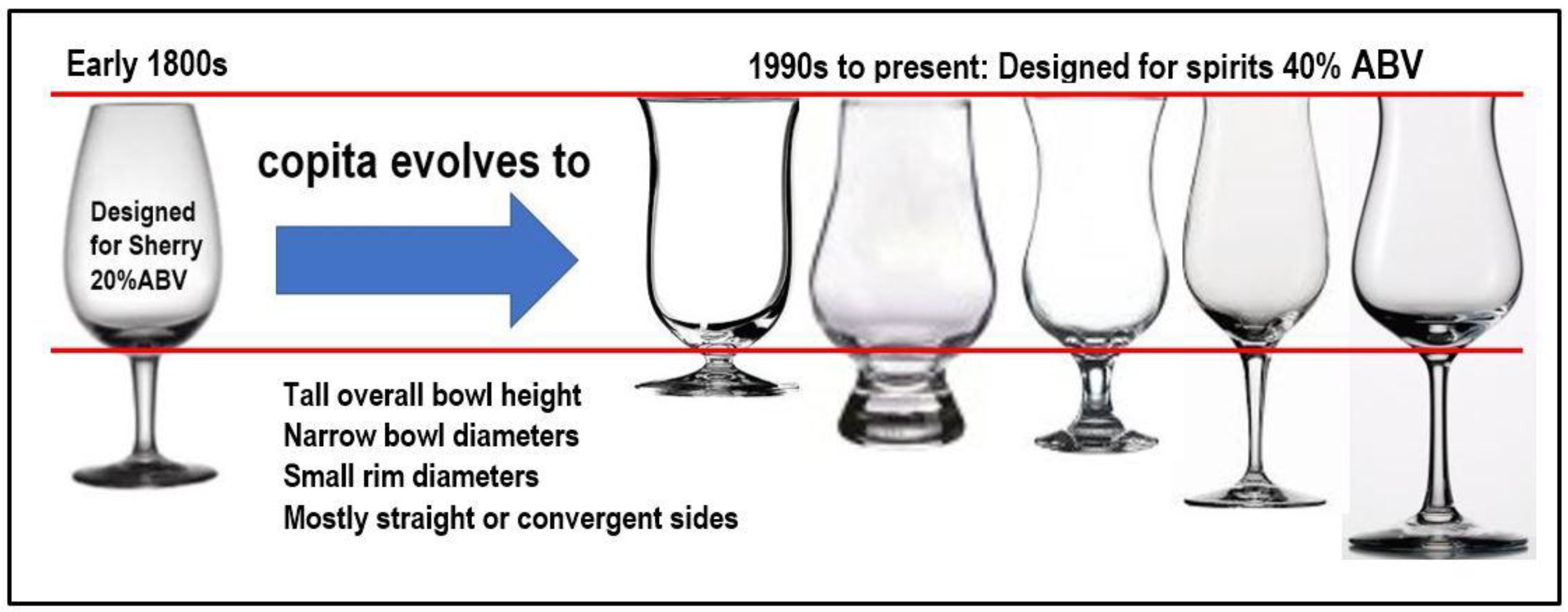
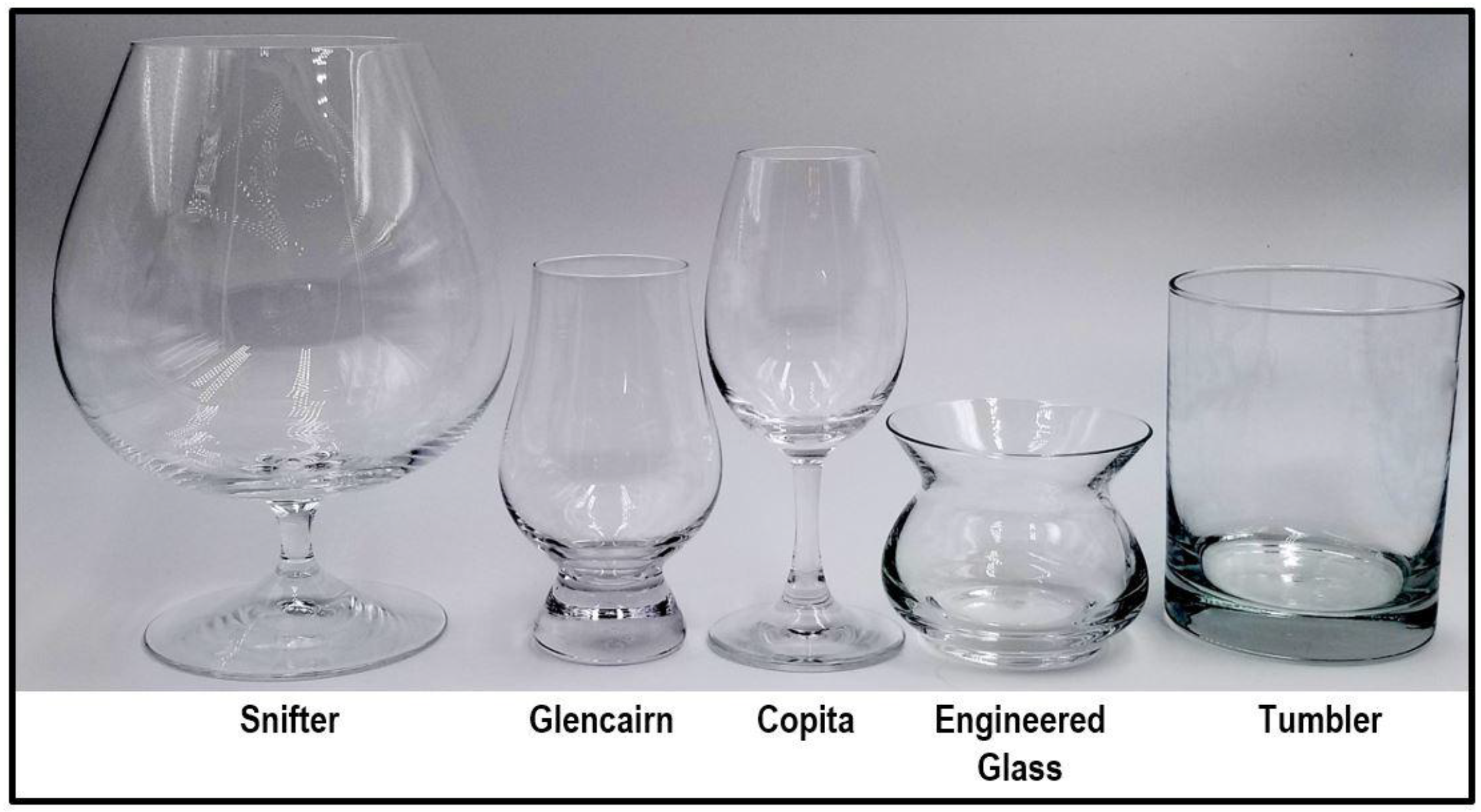
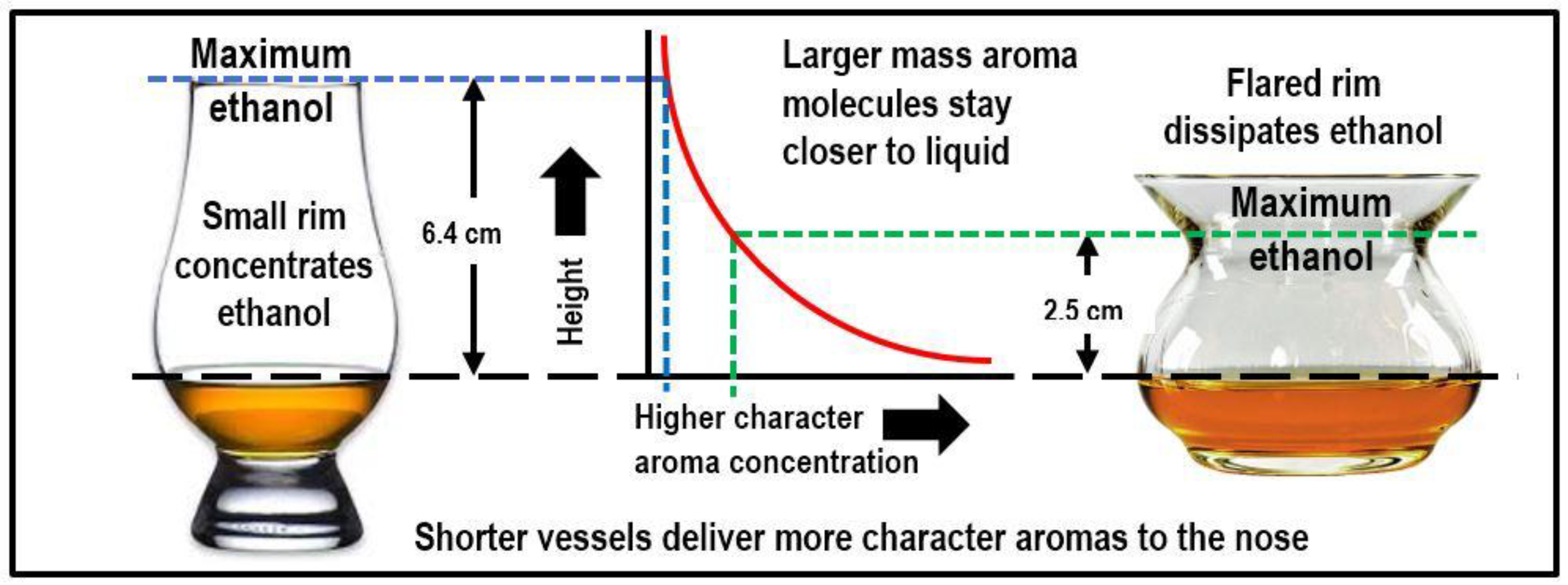
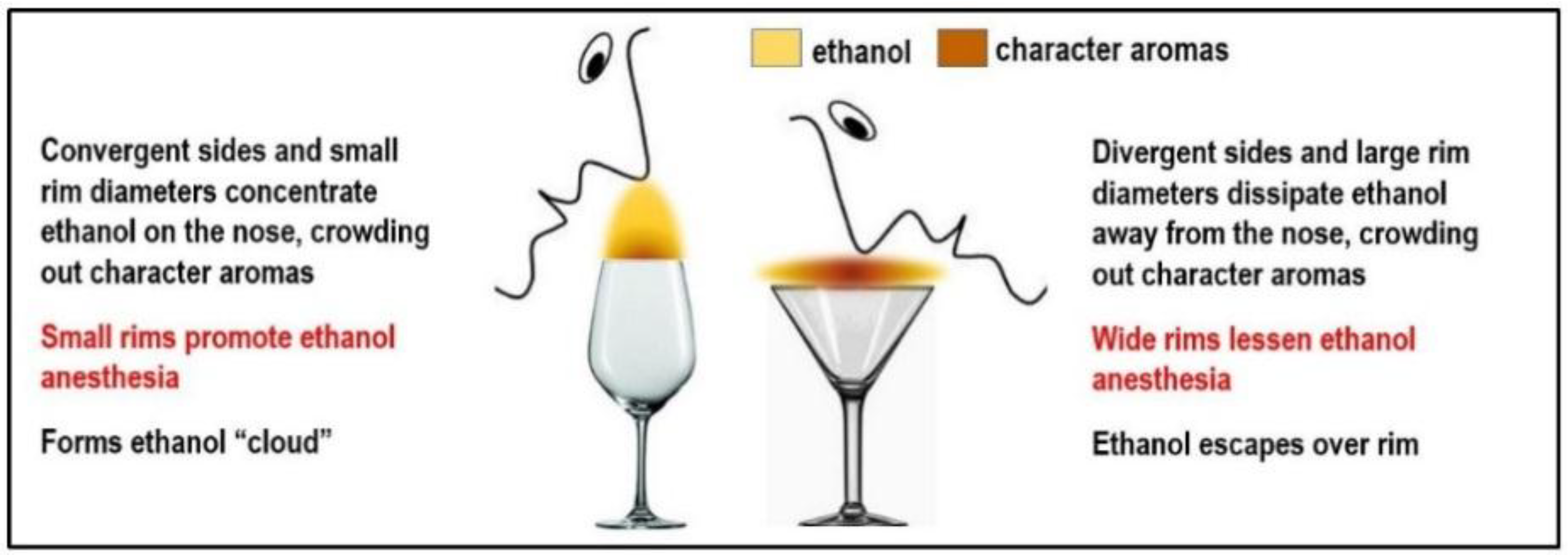
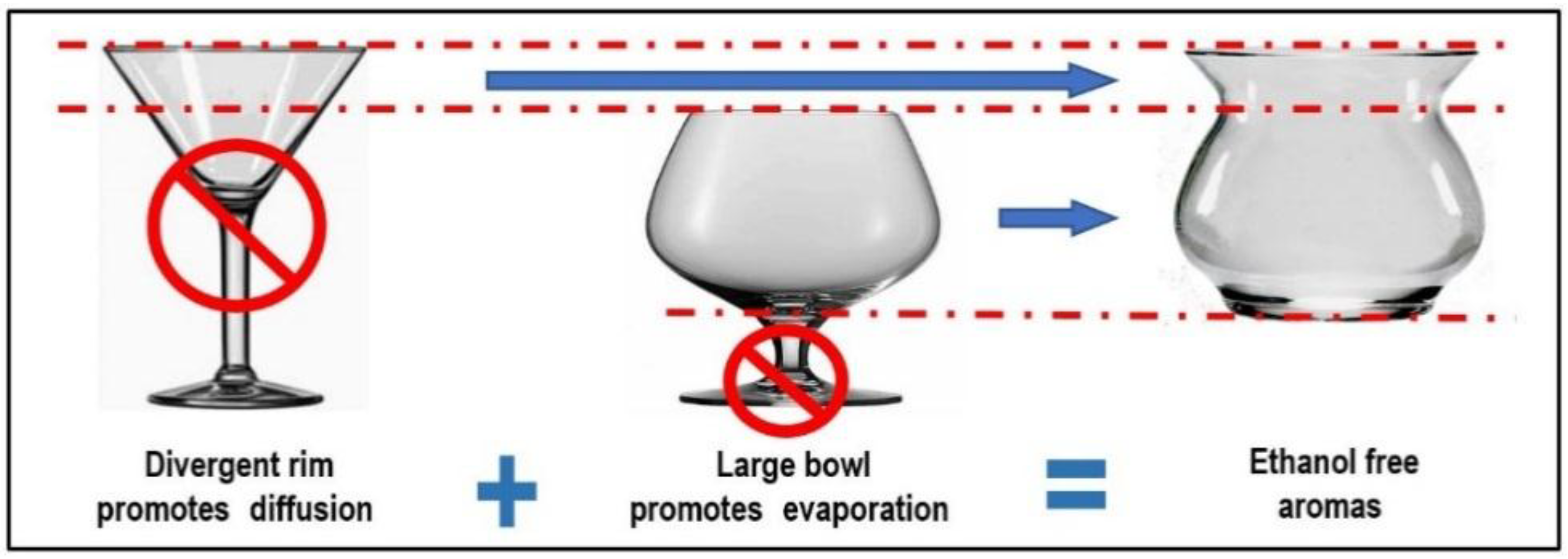
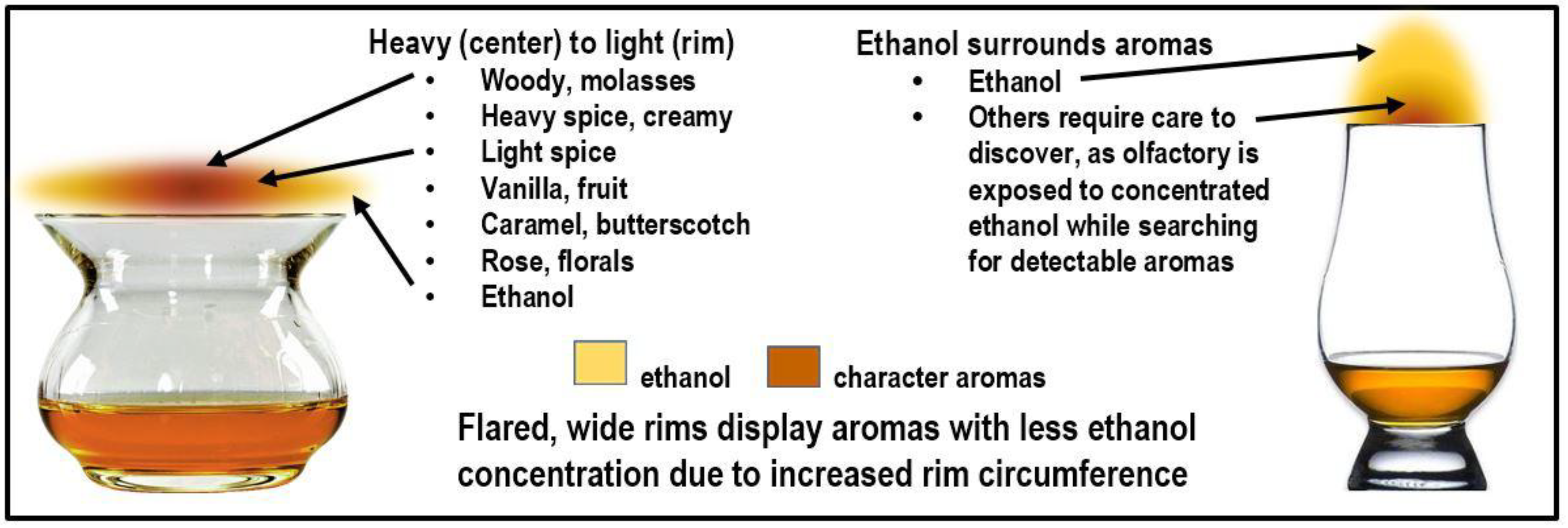
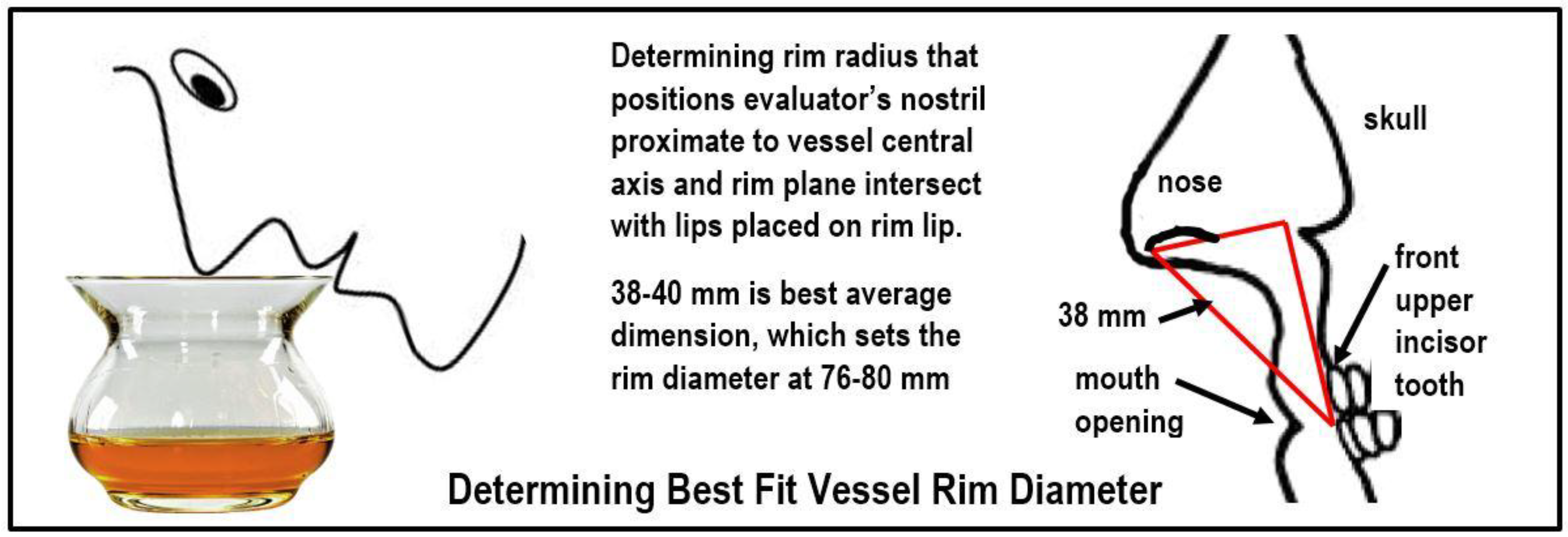

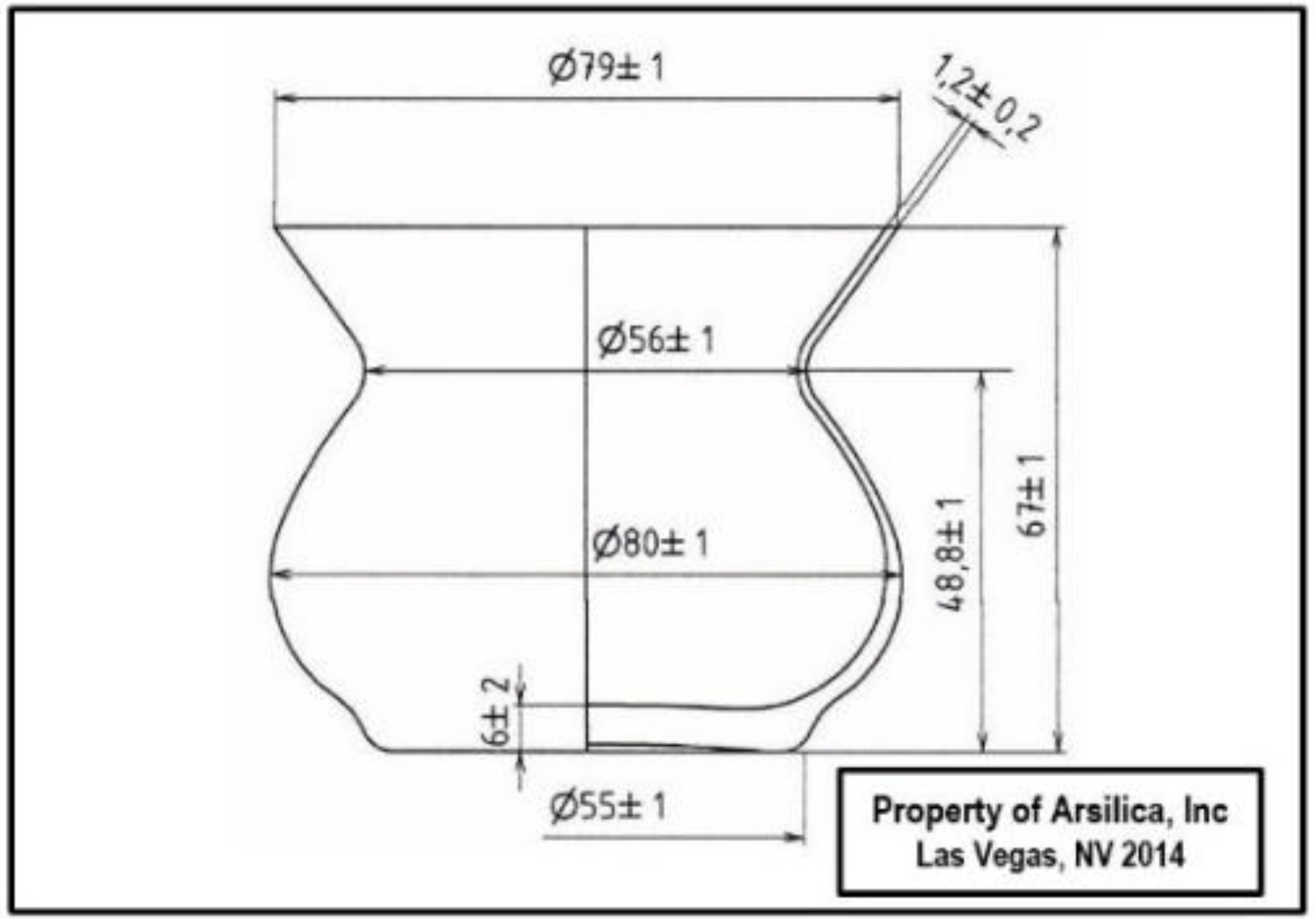
| Chemical Symbol | Molar Mass | Vapor Pressure | Boiling Point | Surface Tension | |
|---|---|---|---|---|---|
| g/mol | kPa at 20 °C | °C | Dynes/cm at 25° | ||
| Water | H2O | 18.02 | 2.34 | 100 | 71.97 |
| Ethanol | C2H5OH | 46.07 | 5.95 | 78.44 | 22.27 |
| Subjective Evaluation I: Existing Common Spirits Vessels | ||
|---|---|---|
 |  |  |
| Tumbler (≈80 mm bowl diam.) | Traditional Copita, Chimney | Snifter (≈100 mm bowl diam.) |
| Popular for ice cubes | Most popular for straight spirits | Least popular |
| Swirls reasonably well | Too narrow to swirl effectively | Swirls best |
| Some ethanol dissipation | Rim concentrates ethanol at nose | No ethanol dissipation |
| Some aromas get to nose | Pungent ethanol crowds out aromas | Very high ethanol |
| Unsatisfactory for 40% ABV spirits | Unsatisfactory, designed for 20% ABV spirits | Designed for quick ethanol “buzz” |
| Wide rim lets nose get close to spirit | Small rim, keeps nose in ethanol cloud | Nose enters strong ethanol cloud |
| Ethanol/character aromas (64/36%) | Ethanol/character aromas (90/10%) | Ethanol/character aromas (79/21%) |
| Consumer Test I: Male vs. Female Preferences for Ethanol Aromas | |||||
|---|---|---|---|---|---|
| Event Location | Total Challenges | Male Prefer Ethanol | Male Prefer no Ethanol | Female Prefer Ethanol | Female Prefer no Ethanol |
| Interviews | Interviews | Interviews | Interviews | ||
| Las Vegas, Jun 2010 (c) | 24 | 2 | 14 | 0 | 8 |
| Las Vegas Jul 2011 (c) | 181 | 14 | 112 | 2 | 53 |
| New York Feb 2011 (c) | 162 | 18 | 111 | 1 | 32 |
| Monterey Oct 2011 (c) | 167 | 17 | 82 | 1 | 67 |
| San Francisco Mar 2012 (c) | 198 | 15 | 125 | 1 | 57 |
| Santa Barbara Sep 2012 (c) | 210 | 18 | 142 | 1 | 49 |
| Portland Oct 2012 (c) | 191 | 16 | 141 | 0 | 34 |
| Miami June 2013 (c) | 182 | 13 | 106 | 1 | 62 |
| Santa Barbara Sep 2013 (c) | 166 | 19 | 111 | 0 | 36 |
| Portland Oct 2013 (g) | 213 | 21 | 136 | 0 | 56 |
| New York Nov 2013 (g) | 226 | 24 | 156 | 0 | 46 |
| San Diego Aug 2014 (g) | 231 | 17 | 118 | 3 | 93 |
| Las Vegas Mar 2014 (g) | 204 | 21 | 123 | 2 | 58 |
| New York Nov 2014 (c) | 188 | 23 | 135 | 0 | 30 |
| San Diego Aug 2014 (g) | 140 | 11 | 89 | 1 | 39 |
| Orlando Mar 2015 (c) | 159 | 14 | 88 | 1 | 56 |
| Las Vegas Mar 2015 (g) | 72 | 9 | 41 | 0 | 22 |
| Total by Gender | 2914 | 272/(12.9%) | 1830/(87.1%) | 14/(1.7%) | 798/(98.3%) |
| Standard Deviation (σ) | 2.23% | 1.37% | |||
| Subjective Evaluation II: Methods Comparison—Traditional vs. C-STEM | ||
|---|---|---|
| Control Spirit | Traditional Evaluation (Ortho-Nasal + Retro-Nasal) | C-STEM Evaluation (Retro-Nasal Only) |
| Bourbon | 10 | 7 |
| Scotch | 7 | 5 |
| Gin | 5 | 3 |
| Simulation I: Aroma Sensitivity During Successive Blind Panel Evaluations | ||||||
|---|---|---|---|---|---|---|
| Judging Event | Flight 1 Vodkas | Flight 2 Gin | Flight 3 Whiskeys | Flight 4 Whiskeys | Lunch Break | Flight 5 Rums |
| A (4 judges) | 4/5 | 6/6 | 4/6 | 3/5 | 45 min | 6/6 |
| B (5 judges) | 5/6 | 7/5 | 5/8 | 3/5 | 1 h | 8/8 |
| C (3 judges) | 4/7 | 5/6 | 3/6 | 3/4 | 1 h | 5/6 |
| D (4 judges) | 5/6 | 5/6 | 4/6 | 4/5 | 30 min | 6/6 |
| Panelist | 7 cm | 5 cm | 3 cm | 2.5 cm | 2 cm | 1 cm |
|---|---|---|---|---|---|---|
| 1 | ethanol | - | butter, caramel | honey, floral, vanilla | oak | spice |
| 2 | ethanol | nuts | honey, floral, caramel | vanilla | spice | - |
| 3 | ethanol | spice | butter, honey, vanilla | flowers, wood | butterscotch | - |
| 4 | ethanol | - | almonds, honey, vanilla | caramel, orange | wood | - |
| 5 | ethanol, floral | butter | honey, vanilla | lilac, caramel | spice | - |
| 6 | ethanol | - | nutty, honey, vanilla | orange, spice | - | - |
| 7 | ethanol, floral | - | butter, caramel | vanilla, honey, spice | - | - |
| 8 | ethanol | - | roses, honey | vanilla, caramel, | wood, spice | - |
| Compound | Aroma | Mol Mass | Diffusion Rate | Location | Type |
|---|---|---|---|---|---|
| CIS-3-Methyl-4-octanolide | spicy coconut | 264.26 | 0.42 | center | lactone |
| Ethyl propanoate | fruity, rum, molasses, eggnog | 211.28 | 0.47 | center | acid ethyl ester |
| TRANS-3-Methyl-4-Octanolide | wood, coconut, honey | 208.21 | 0.47 | center | lactone |
| 2-methyl propanol | malty, dark chocolate | 192.12 | 0.49 | center | aldehyde |
| β-Damascenone | rose, grape, earthy, green floral | 190.28 | 0.49 | center | ketone |
| Syringaldehyde | spicy woody | 182.17 | 0.50 | center | aldehyde |
| Gamma-Decalactone | peach, apricot | 170.25 | 0.52 | center | lactone |
| Eugenol | medicinal, spicy cloves | 164.20 | 0.53 | mid | phenolic |
| Vanillin | sweet vanilla, creamy | 152.15 | 0.55 | mid | aldehyde |
| Ethyl Hexanoate | sweet apple, pineapple, waxy | 144.21 | 0.57 | mid | acid ethyl ester |
| 2-methyl-3-(methyldisulfanyl) furan | meat, sulfur | 140.14 | 0.57 | mid | heteroaromatic |
| Isoamyl Acetate | banana, pear, ripe | 130.18 | 0.59 | mid | acid ethyl ester |
| Sotolon (caramel furanone) | caramel, maple, fenugreek | 128.13 | 0.60 | mid | lactone |
| Guaiacol | peat smoke, spice, leather | 124.14 | 0.61 | mid | phenolic |
| Phenethyl alcohol | floral, rose | 122.16 | 0.61 | mid | alcohol |
| Ethyl isobutyrate | butterscotch | 116.16 | 0.63 | mid | acid ethyl ester |
| Meta-Cresol | band-aid | 108.14 | 0.65 | mid | phenolic |
| Ortho-Cresol | medicinal, sweet phenolic | 108.14 | 0.65 | mid | Phenolic |
| Para-Cresol | medicinal, sweaty, pig-sty | 108.14 | 0.65 | mid | phenolic |
| Hexanal | green grass, vegetal, leafy | 100.16 | 0.68 | mid | aldehyde |
| Furfural | almond, grain | 96.08 | 0.69 | mid | aldehyde |
| Diacetyl | butter | 86.09 | 0.73 | rim | vicinal diketone |
| Ethyl Alcohol | ethanol | 46.07 | 1.00 | rim | alcohol |
| Source of Data | Avg. Length (mm) |
|---|---|
| Adult permanent maxillary central incisor length (7 sources) | 23.5 |
| Skull nasal opening to incisor root end (5 sources) | 7 |
| Flesh at lower nasal passage over skull (approximation) | 2 |
| Upper lip below incisor edge (approximation) | 2 |
| Total vertical leg distance (skull upright) | 34.5 |
| Total horizontal leg distance (skull upright, approximation) | 17 |
| Hypotenuse calculation (approximate vessel radius) | 38.45 |
© 2018 by the author. Licensee MDPI, Basel, Switzerland. This article is an open access article distributed under the terms and conditions of the Creative Commons Attribution (CC BY) license (http://creativecommons.org/licenses/by/4.0/).
Share and Cite
Manska, G.F. Technical Report—Applying Physics and Sensory Sciences to Spirits Nosing Vessel Design to Improve Evaluation Diagnostics and Drinking Enjoyment. Beverages 2018, 4, 93. https://doi.org/10.3390/beverages4040093
Manska GF. Technical Report—Applying Physics and Sensory Sciences to Spirits Nosing Vessel Design to Improve Evaluation Diagnostics and Drinking Enjoyment. Beverages. 2018; 4(4):93. https://doi.org/10.3390/beverages4040093
Chicago/Turabian StyleManska, George F. 2018. "Technical Report—Applying Physics and Sensory Sciences to Spirits Nosing Vessel Design to Improve Evaluation Diagnostics and Drinking Enjoyment" Beverages 4, no. 4: 93. https://doi.org/10.3390/beverages4040093
APA StyleManska, G. F. (2018). Technical Report—Applying Physics and Sensory Sciences to Spirits Nosing Vessel Design to Improve Evaluation Diagnostics and Drinking Enjoyment. Beverages, 4(4), 93. https://doi.org/10.3390/beverages4040093




